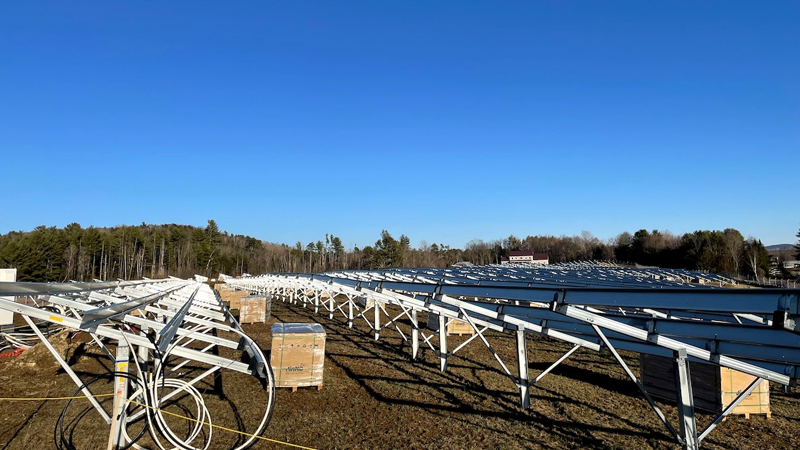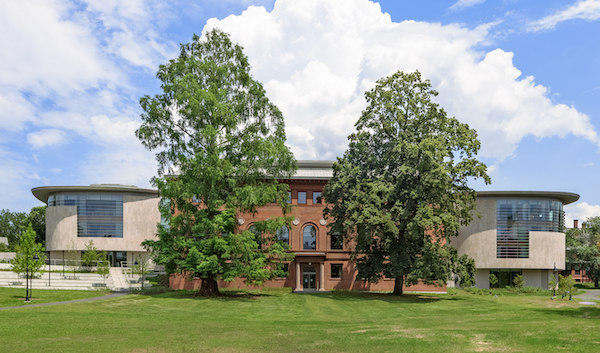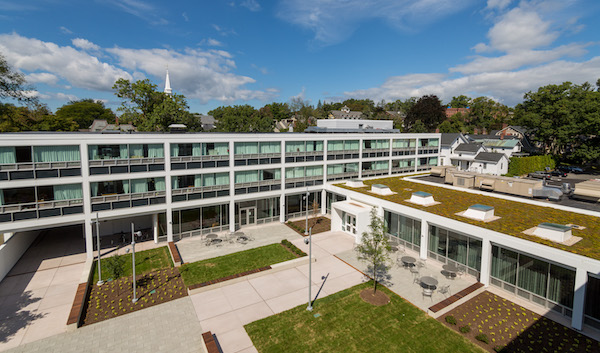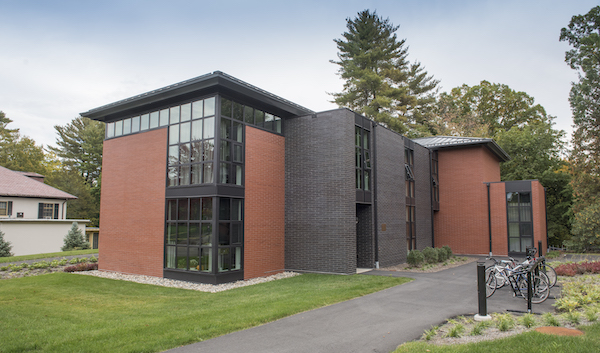Energy Efficiency and Conservation

Energy efficiency and conservation are critical components of financially prudent and resource-responsible institutional operations. Minimizing our consumption of energy reduces how much renewable energy we need to generate or purchase, thereby reducing operating expenses that can be redirected to other preferred purposes. Energy conservation is the foundation of a strong carbon neutrality plan.
Through student research and our regular GHG reporting, we know buildings account for 87 percent of our scope 1 carbon emissions. Over the past 30 years we have implemented waves of building energy upgrades including LED lighting, double-pane windows, building sealing, insulation, equipment replacement, and more.
Smith’s building portfolio consists of roughly 120 buildings totalling approximately 3.2 million square feet. We are a college with a long history and our buildings are part of that story ranging from 200 years old to our brand new library that opened in Spring 2021. Some building efficiency activities can be applied to all building types, while many are nuanced to the particular building construction, equipment, and use. Maximizing building efficiency and temperature comfort can be achieved by implementing the easy and obvious upgrades, as well as the complicated and expensive equipment and building conversions.
Through integrative projects that apply academic research to institutional and real-world sustainability challenges - our students, faculty, and staff work to promote energy conservation and ensure that new buildings are highly energy efficient, old buildings are retrofitted to promote greater efficiency, and our energy supply continues to become cleaner.
In the mid-2000’s, we focused in earnest on electricity consumption by converting lights throughout campus.
In the early 2010’s, the college developed its first sustainability action plan. We knew efficiency should be a critical part of our climate action plan, but didn’t know how much greenhouse gas reduction could be attained through building efficiency. We therefore could not set specific and measurable building efficiency goals without understanding the unique opportunities of our complex building portfolio. The Office of Sustainability engaged Professor Denise McKahn and student Etta Grover-Silva ‘10 to predict the degree to which building energy upgrades could reduce carbon emissions and at what cost. Through their research, they developed a method to model building structural types and existing thermal performance in order to evaluate the degree of retrofit that maximizes capital investment across an entire campus when no metered data is available. In the first half of the 2010’s, the college used money from our gas supplier to install dense-pack insulation in walls and attics across the college.
In the second half of the decade, the capital and construction team began focusing on opportunistic and strategic upgrades to mechanical equipment, right-sizing hot water storage, and more intelligent building management systems.
Lighting Upgrades - Spotlight Projects
Smith College Museum of Art (SCMA) - Lighting in art display spaces is critically important. The right lighting enables the viewer to fully experience the art. The wrong lighting can degrade the art as well as diminish the piece’s impact. Starting in 2014, LED fixtures replaced incandescent bulbs throughout the SCMA’s galleries, classrooms, and other display areas. The museum found multiple benefits in the change as LEDs do not emit heat that degrades artwork, and they light pieces better than other bulbs since they have a less yellow hue. Energy efficiency is thus enhancing the experience of the museum’s collection.
Indoor Track and Tennis Complex (ITT) - In 2013, the lighting in the college’s main athletic complex was converted to LED. Almost immediately, the conversion halved the amount of energy required to light the ITT. The upgrade saves approximately $34,000 in annual savings. And another win: the LED lighting is so much brighter than the previous fluorescent lighting in the ITT that some tennis players have noticed their game has improved.
Green and Efficient Buildings
For most new construction since 2008, we’ve adhered to LEED (Leadership in Energy and Environmental Design) standards, and in 2014, we certified the Bechtel Environmental Classroom at MacLeish Field Station as a Living Building.
Neilson Library

With its emphasis on natural light, sustainable design principles, and flexible interiors that lend themselves to the most efficient use of space, the “New Neilson,” which opened in Spring 2021, is a significant addition to green buildings on campus. The building is made from local, regional and recycled materials. An ocular sunscoop—a round skylight with a reflective curved wall—fills the heart of the library with natural light as a ground-to-roof skylight. It brings the maximum amount of natural light into the heart of the main structure. The curved walls of the “jewel boxes” on both sides of the building and horizontal window louvers increase the building's efficiency. Read more about the sustainability features of the building.
Ford Hall Science and Engineering Building (2010), LEED Gold certified

Ford Hall was built with impressive energy-recovery and lighting systems, a layout that promotes optimal air circulation, and recycled materials. During construction, the waste recycling rate was 95 percent, significantly higher than the norm. Its green roof recaptures and filters rainwater and contributes to significant heat savings. Since its opening in 2010, a solar array has been added to its roof.
Cutter and Ziskind Houses (2012), LEED Silver certified

Built in 1955, the Cutter-Ziskind residence complex is 60-years-new. Its mid-century modern design was recently brought into the 21st century during a 2012 renovation that included high-performance glass, energy-efficient building updates, and water-saving plumbing fixtures. Creating a green roof and expanding the green space around the complex were other key renovations, along with new skylights.
Friedman Apartment Complex (2016), LEED Gold certified

The Friedman Apartment Complex, opened in 2016, incorporates sustainable design standards certified LEED Gold. Thanks to thick insulation and double-glazed windows, it takes very little energy to heat and cool the complex. The site has 50 percent less impervious space than existed before the apartments’ construction, which means less water runoff into the surrounding neighborhood and woods.
Bechtel Environmental Classroom (2012), Living Building Challenge certified

Supported by a grant from the S. D. Bechtel Jr. Foundation, Smith College completed the construction of a 2,300-square-foot building at the MacLeish Field Station in 2012. A 9.4-kW solar array generates more electricity than the building uses on an annual basis. In 2014, the building was designated as the fifth fully certified Living Building worldwide, having completed the rigorous Living Building Challenge overseen by the International Living Futures Institute. The building contains a seminar and lecture space, a "dry" lab room, a small office, a kitchenette, and two composting toilets.
Conway House (2006), EnergyStar Rated

Built in 2006 for Ada Comstock scholars, Conway House boasts a 5+ EnergyStar rating from the EPA. Its ten apartments have EnergyStar appliances, but the key to this building’s low energy use is extensive insulation. Walls and ceilings hold more than a foot of expanded polystyrene foam, the least toxic type at the time. Because of the materials used for the envelope, the building is virtually airtight.
Electricity Load Reduction Partnership with Electricity Provider
Smith participates in a program with our electricity provider that reduces the stress on the electricity grid during particularly hot days. When Smith received an alert from our provider, the following day we will completely generate our own electricity through our on-site co-generation power plant for the requested period of time. This program saves Smith money and cools the campus.
Behavior Change Projects and Programs
Shut the Sash Initiative in Lab Spaces
In 2016, Angelica Radke ‘18 launched Smith’s “Shut the Sash” initiative, a campaign to encourage chemistry lab users to close fume hoods to save energy, reduce carbon emissions, and improve safety. Open fume hoods cost about four times as much to operate and release four times as much carbon as closed hoods. It’s been estimated that closing fume hoods could save as much as $1,100 per hood annually, and with approximately 150 fume hoods on campus, that represents significant savings and a significant benefit to the environment. Sash closing is now a common and expected practice in our labs serving both a safety and environmental benefit.
House Sustainability Challenge
In spring 2018, the House Sustainability Challenge (sponsored by a collective of college units) gave students a chance to pitch ideas for programs that would promote sustainable living and behavior in the houses. The winning team, Yolanda Chigiji '21, Emma Krasky '21 and Julianne Borger '21, proposed a new laundry drying-rack system to save energy. In 2020 the system was fully implemented and is monitored by the House Eco-Reps.
